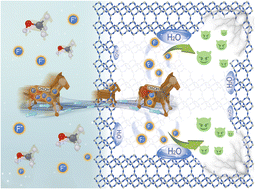In situ hierarchical pore engineering in small pore zeolite via methanol-mediated NH4F etching†
Abstract
Hierarchical zeolites have attracted significant attention from both academic and industrial communities due to their exceptional mass transport and accessibility to active sites while maintaining the shape selectivity of the zeolite. However, creating a hierarchical structure over small-pore zeolites remains a formidable challenge. In this study, we propose a novel approach that utilizes a methanol-mediated NH4F etching method to fabricate hierarchical SSZ-13 zeolite with well-distributed mesopores. Unlike the conventional aqueous NH4F etching process, the utilization of methanol as a solvent allows for the effective suppression of NH4F reactivity during its transport into the zeolite channels. NH4F remains inactive until exposed to resident water molecules in zeolite, and the subsequent hydrolysis process in situ activates the release of etching species, effectively eliminating the framework Si and Al species and allowing for uniform and controllable etching. Solid-state nuclear magnetic resonance spectroscopy provides in-depth insight into the etchant interactions with the framework defect sites and the evolution of aluminate and silicate species from framework to extra-framework, elucidating the structural and chemical changes occurring during the process. Our work presents an efficient strategy for the preparation of hierarchical zeolites with well-dispersed mesopores, offering opportunities for tailored pore engineering and holding potential for various applications such as catalysis, adsorption, and separation.

- This article is part of the themed collections: Journal of Materials Chemistry A Emerging Investigators and #MyFirstJMCA


 Please wait while we load your content...
Please wait while we load your content...